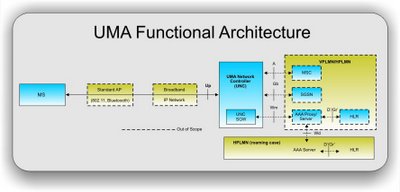Unlicensed Mobile Access (UMA) technology provides access to GSM and GPRS mobile services over unlicensed spectrum technologies, including Bluetooth and 802.11. By deploying UMA technology, service providers can enable subscribers to roam and handover between cellular networks and public and private unlicensed wireless networks using dual-mode mobile handsets. With UMA, subscribers receive a consistent user experience for their mobile voice and data services as they transition between networks.
In order to promote the widespread adoption of UMA technology, a number of leading companies within the wireless industry have jointly developed a set of open specifications. These specifications are available through this Web site, and may be used by vendors and carriers of wireless communications systems and applications to develop and deploy interoperable solutions.
In addition to developing and maintaining the initial specifications, the participating companies are actively working with the 3GPP standards organization to use the specifications as the basis for the development of a formal standard.
Highlights of UMA Technology:
- Seamless delivery of mobile voice and data services over unlicensed wireless networks.
- Provides the same mobile identity on Cellular RAN and unlicensed wireless networks.
- Seamless transitions (roaming and handover) between Cellular RAN and unlicensed wireless networks.
- Preserves investment in existing/future mobile core network infrastructure
- Independent of underlying unlicensed spectrum technology (e.g. WiFi™, Bluetooth™)
- Transparent to existing, standard CPE devices (e.g. access points, routers and modems)
- Utilizes standard “always on" broadband IP access networks (e.g. DSL, Cable, T1/E1, Broadband Wireless, FTTH…)
- Security equivalent to current GSM mobile networks
- No impact to operations of Cellular RAN (e.g. spectrum engineering, cell planning,…)
UMA Technology Architecture
UMA Technology Operation
UMA technology provides alternative access to GSM and GPRS core network services via IP-based broadband connections. In order to deliver a seamless user experience, the specifications define a new network element (the UMA Network Controller, UNC) and associated protocols that provide for the secure transport of GSM/GPRS signalling and user plane traffic over IP. The UNC interfaces into the core network via existing 3GPP specified A/Gb interfaces.
How UMA Technology Works
- A mobile subscriber with a UMA-enabled, dual-mode handset moves within range of an unlicensed wireless network to which the handset is allowed to connect.
- Upon connecting, the handset contacts the UMA Network Controller (UNC) over the broadband IP access network to be authenticated and authorized to access GSM voice and GPRS data services via the unlicensed wireless network.
- If approved, the subscriber’s current location information stored in the core network is updated, and from that point on all mobile voice and data traffic is routed to the handset via the Unlicensed Mobile Access Network (UMAN) rather than the cellular radio access network (RAN).
- ROAMING: When a UMA-enabled subscriber moves outside the range of an unlicensed wireless network to which they are connected, the UNC and handset facilitate roaming back to the licensed outdoor network. This roaming process is completely transparent to the subscriber.
- HANDOVER: If a subscriber is on an active GSM voice call or GPRS data session when they come within range (or out of range) of an unlicensed wireless network, that voice call or data session can automatically handover between access networks with no discernable service interruption. Handovers are completely transparent to the subscriber.
UMA Interoperability
An open test specification is under development that can be used to facilitate interoperability testing between implementations. The test specification will be available through this web site. Companies planning to implement products based on the UMA specifications should seek bilateral compliancy testing agreements directly with other vendors.
In principle, the UMA specifications ensure interoperability similar to any other industry specifications, but the specifications may include options and parameters that have to be agreed bilaterally with other vendors. The UMA participating companies do not guarantee interoperability and the specifications may be upgraded without notice.
1 comment:
This is great info to know.
Post a Comment